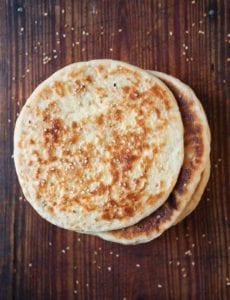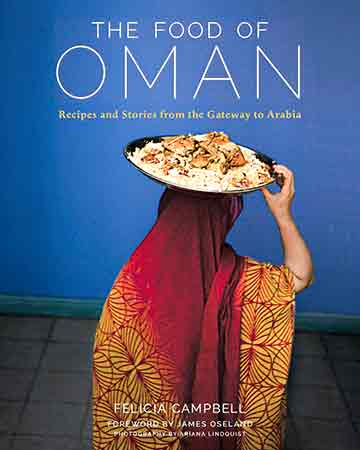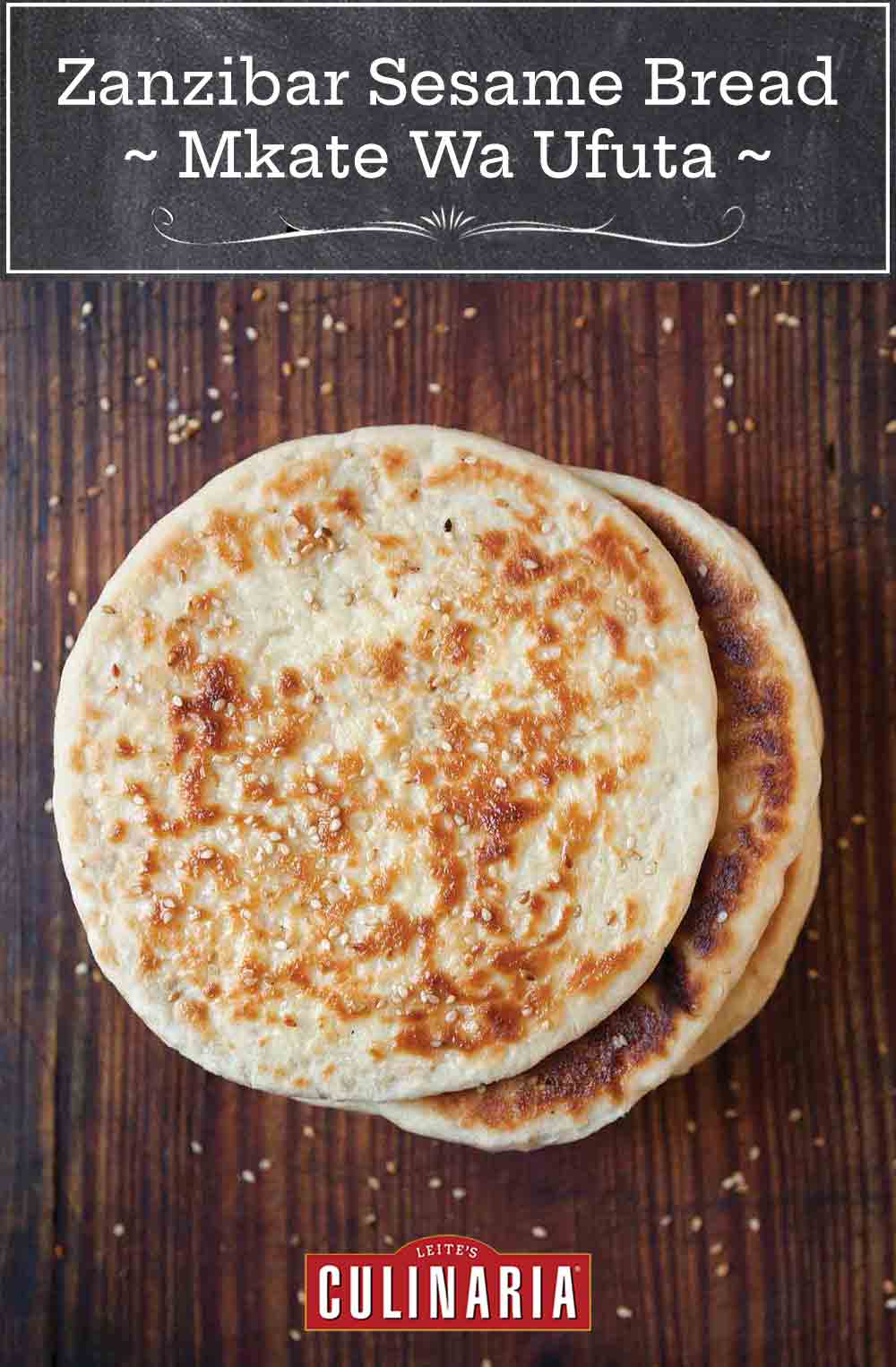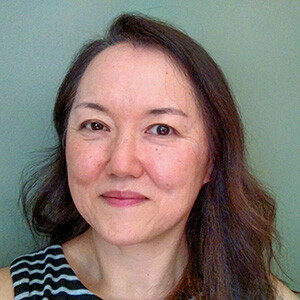
Mkate wa ufuta. We know what you’re thinking. Mkate what?! Yet once you try this unique and chewy, toasty, nutty, densely magnificent sesame flatbread from Zanzibar, you’ll be crooning about it to everyone who’ll listen, even if you don’t know what the name means. It’s essentially a dense griddle bread that’s more about texture than taste. It’s perfect for dipping or dunking or sopping or plain old noshing. As for that name, we’re not quite certain how to pronounce it, even after much research. But you can bet we practice saying it each time we make mkate wa ufuta, which has been often.–Angie Zoobkoff

Zanzibar Sesame Bread ~ Mkate Wa Ufuta
Ingredients
- 3 1/2 cups unbleached all-purpose flour
- 2 1/4 teaspoons active dry yeast
- 1 1/2 teaspoons kosher salt
- 1 cup plus 2 tablespoons full-fat canned coconut milk, plus more as needed
- 1 large egg
- 1/4 cup mild olive oil or vegetable oil
- 3 to 4 tablespoons sesame seeds (toasted or untoasted)
Instructions
- Stir in the coconut milk and egg just until combined and knead everything in the bowl or turn it onto a lightly floured work surface. At first the ingredients will be a shaggy mess but eventually a smooth dough will form if you use a lot of strength, usually after 5 to 7 minutes. The dough will be dense and firm rather than spongy and soft. If it seems impossibly dry, add another tablespoon coconut milk as you knead. (Alternatively, you can make the dough in your stand mixer and knead it hands-free for about the same amount of time.)
- Cover the bowl containing the dough with a damp kitchen towel and place it in a warm place to rest for 30 to 60 minutes. The dough will rise slightly and become puffier and softer but it won’t necessarily double in size as we’re accustomed to with most yeasted bread doughs. It’s really more about the resting than the rising.
☞ TESTER TIP: If you want slightly less dense bread, then let the dough rest in a very warm place, such as an oven with the pilot light on, and wait for the dough to nearly double in size.
- Divide the dough into 6 balls. Pat each ball or slap it between the palms of your hands to form a round shape about 6 1/2 inches wide and between 1/4 and 1/2 inch thick. Place the dough rounds on your work surface, rub the top side of each dough round fairly generously with oil, and sprinkle each with 1/2 to 1 teaspoon sesame seeds, being certain to gently press the seeds into the dough.
- Heat a large saute pan or cast-iron skillet over medium heat. Place a dough round in the skillet, sesame side down, and cook until the top side puffs ever so slightly and the underside turns golden brown, 1 1/2 to 2 minutes. It may be necessary to reduce the heat to medium-low to find the sweet spot where the bread cooks through but doesn’t become too brown.
- Drizzle the top of the dough with oil, rub it over the surface, sprinkle with some sesame seeds and a little salt, and then flip the dough. Cook until the other side is lightly browned and cooked in the middle, 1 to 2 minutes more.
- Transfer the cooked bread to a plate, carefully wipe out the pan with paper towels, and repeat with the remaining dough. (Be certain to wipe out the pan after each bread to remove any lost sesame seeds and prevent them from burning.)
- Serve the bread warm—preferably straight from the skillet—whether alone, slathered with butter, dipped in pan juices, or dunked into soup, stew, or curry.

Explore More with AI
Nutrition
Nutrition information is automatically calculated, so should only be used as an approximation.
Recipe Testers’ Reviews
This mkate wa ufuta, or Zanzibar sesame bread, is a very easy recipe and absolutely delicious. It’s a soft, chewy bread with a slight crunch from the sesame seeds. It didn’t taste like coconut at all, contrary to what I expected. I am really happy with this bread.
This bread proofs extremely slowly. I had it on the counter for about 1 hour, with almost no change. Then I put it in the oven, with the lamp on only, and let it double, which took about 2 more hours.
We ate the bread warm with red lentil soup. Really nice.
I’m not sure exactly what I was expecting with this mkate wa ufuta bread, but it pleasantly surprised me with both its simplicity and flavor. I made it on a day when I felt like I didn’t have the time for starting a traditional loaf of bread but I wanted some fresh bread to serve with the slow cooker Irish beef stew we were having for dinner. This recipe looked promising and turned out to be a great choice.
I kneaded the dough for 15 minutes (well over the 5 to 7 minutes mentioned in the recipe) and i t never really got smooth, although it was a little smoother after 15 minutes. It was a tough dough to knead, not light and springy, but heavy and solid. Once it had risen, though, it was much softer and easier to work with. After 30 minutes, the dough had not risen much, if at all. I let it rise for 30 minutes longer and at that point it had approximately doubled in size. I cooked it for 2 minutes per side.
While it was cooking, it smelled so good that I could not stop myself from trying one hot out of the pan. It was wonderful with its soft, steaming interior and toasted sesame flavor. It remained soft inside and flavorful once it cooled, but I found it was best when eaten within a day of being cooked. The bread was best warm out of the pan, but also quite good once it had cooled down. We ate it with a hearty beef stew to sop up the stew juices, but it was also wonderful on its own as an appetizer, no butter necessary.
This AMAZING flatbread is very easy to prepare with little prep and a single quick rise. They looked like an ordinary flatbread but as I took my first bite I was pleasantly surprised by the subtle nuttiness from the sesame seeds and the mild sweetness of the coconut milk—truly a match made in heaven. We are certain to enjoy these little gems quite regularly in the future!
I actually let the dough rise for almost an hour and it nearly doubled in size.
I would recommend using raw sesame seeds as they will be toasted while you fry the bread. When you preheat your cast iron skillet, you will not need oil because each side of the bread will be nicely oiled before you drop them in the skillet. I used about a teaspoon of seeds on either side of the bread. Don’t forget to add a pinch of salt to the top side of each mkate wa ufuta before you flip it. The breads puffed up beautifully as they brown in the skillet.
This tasty and fragrant griddle bread is fun to make and quick, too. The mkate wa ufuta dough can be mixed and kneaded right in the bowl and it also rises in that same bowl—and only once for a relatively short amount of time. The bread is as versatile as a baguette—good any time of the day and with just about anything, including scrambled eggs, a simple salad, and African peanut stew. (The bread was great for sopping up the sauce.)
To minimize the amount of sesame seeds falling off the bread, I recommend pressing them lightly into the dough. The bread is perfectly fine at room temperature but the texture is better when warm. To refresh it, just wrap it in foil (you can stack the rounds—they don’t stick) and rewarm for 10 to 15 minutes in a 350°F oven.
Despite containing coconut milk, this mkate wa ufuta is not a sweet bread, nor does it retain much coconut flavor once it’s room temperature. What the coconut milk does add is a wonderful and unique component which creates a luscious texture similar to using butter.
As the dough came together, I found it to be dense and dry and I got quite a workout incorporating all the flour into the mass and creating a smooth texture. Total kneading time was 7 minutes. Because the yeast is added directly to the flour rather than initiating fermentation in the liquid ingredients, I didn’t get much of a rise in 30 or even 45 minutes. In fact, this step seemed to be geared toward resting the dough so you can shape it rather than rising the dough. When forming flat rounds from the 6 portions, I found slapping the dough from palm to palm helped to stretch and shape it.
Once shaped, each flat received about a 1/2 teaspoon of raw sesame seeds on the first side. If you have a long two-burner cast-iron griddle, I’d recommend using that to fry up the flatbreads. Once flipped, I found the second side never cooked up as nicely as the first so it is important to get side number one good and crisp and speckled with brown. The finished texture was dense with a tiny fermentation pockets yet luscious and crisp like a good southern biscuit. The bites with flecks of salt were my favorite and I recommend salting both sides lightly.
I would use these flatbreads for many dishes that require sopping and mopping of plates; however, the flatbreads would be equally good as vehicles for open-face tartines of smashed avocados or spicy chicken salads. Truth be told, I just stood in the kitchen snitching bits of warm bread until I found I had scarfed down almost two.
These mkate wa ufuta turned out exactly as described in the recipe—dense, chewy, and with a lovely toasted sesame flavor. The flavor was great, the toasted seeds were so good. The texture was very dense and chewy, but that is how it was described. It reminded me of a dense green onion cake—without the onions. That being said, they are quite heavy as it’s essentially fried bread dough. I ate one and was stuffed! If I were to make these again, I might try to activate the yeast in some of the milk first, as my dough rose very little and there was very little “puffing” during the cooking.
I found it strange that it did not recommend proofing the yeast first, but I proceeded with the recipe as directed. The dough was quite dry and after kneading for 2 minutes it was not fully combined, so I added 1 extra 1tbsp of coconut milk, which brought everything together and yielded a smooth dough after 6 minutes of kneading. Definitely seemed like a good dipping bread, so it went along nicely with a bowl of thick soup.
I made this mkate wa ufuta twice because I wanted to get a better sense of it and I love fry breads. The first time I made this, I used sesame seeds and oil as directed. I turned it to medium low and it worked really well. The second time I made it without the sesame seeds and it was really great and the flavor of the coconut milk came out.
Iʻm not sure which I like better. I love sesame and so the sesame seeds are good but I loved the coconut flavor, too. I could see not using the brush and sesame seed process if you want to get things done faster because it tastes great either way. I used untoasted sesame seeds.
I loved this mkate wa ufuta bread! It was quick, easy, and delicious! And it was really nice to be able to make bread in less than an hour. The sesame seeds give this dense chewy bread a nice crunch and a toasted sesame flavor. The sesame smell lingered throughout the house for the rest of the night. My husband has already asked me to make this bread again!
I used untoasted sesame seeds as the seeds end up being toasted while the bread cooks. It took about 7 minutes to knead the dough and I had to add a tablespoon more liquid because the dough seemed a little dry. I let the bread rise for 30 minutes. It didn’t seem to rise much but the dough felt good and was springy and soft. I used about a teaspoon sesame seeds per bread. You end up losing a couple seeds during cooking so I was sure to put plenty on.
The bread cooks best if you really coat it with oil. The first one I cooked I only lightly brushed the oil on and the bread didn’t get much color and took longer to cook through. The oil works as a good vehicle for the heat to really get in contact with the bread. I loved the bread warm and cold! The first time we ate it we served it with a nice pumpkin chili. The second time we ate it we warmed it up in the toaster oven and had it with some eggs for breakfast.
I really enjoyed this chewy sesame bread. It was good dipped in curried soup and also warmed for breakfast the next day with tahini and honey and a cup of tea. Even those who don’t like coconut will like this mkata wa ufuta as the coconut milk doesn’t really add any discernible coconut flavor. It tasted best fresh off the griddle but also reheated nicely in the oven.
I would eat it at room temperature if given to me but warm is so much nicer! Because it is only me, I cooked 3 rounds of dough and put the rest in the freezer for another day.
I have really been into breadmaking lately and was very excited to make this traditional Zanzibari sesame bread. I find bread to be one of the most rewarding things you can make in the kitchen. Not only did the flavor combination of the coconut milk and sesame seeds intrigue me, but the simple cooking method was very appealing. The results were as described—a chewy round bread that was toasty with the sesame seeds on the outside but very tender on the inside.
In terms of the mkate wa ufuta recipe itself, the dough was a very smooth and rich dough, thanks to the coconut milk. And it has a wonderful smell as you knead it! I kneaded my bread for about 5 minutes before it was smooth in texture. I let the bread rise in the kitchen for about 1 1/2 hours and it got to about double its original size. I put about 1/4 teaspoon of sesame seeds on each dough round. I knew I was adding more to the other side later, so this amount worked well. I cooked the first side for 1 1 /2 minutes and then the second side for just 1 minute. The pan was very hot, so I didn’t want the bread or the seeds to burn!
The texture of the bread was very nice and we were thrilled with the results. We ate the bread warm and dipped it in the juices of a chicken dish. I think these would also be great with some hummus or flavored oil to dip in or maybe even with a sprinkling of sugar for a sweet breakfast treat?

















Can this be made with whole wheat flour?
Hi, Lee. We didn’t test it that way. There will be certain adjustments you’ll need to make, primarily with the amount of liquid you use. But because we didn’t test it I can’t tell you exactly how much. If you do try it, let us know how it turns out!
My mom used to work for the Ambassador of Tanzania, and his chef would make this amazing bread. He also made a stew, I have no idea what it was called but it was made with chicken and I am not sure if it was nutty or coconutty, but it was heavenly and tastes great with the bread. Could anyone venture a guess as to what this stew could be? I imagine it was a local or regional dish. I would love to find the recipe and prepare it together with the bread. Thanks for posting this recipe, it brings me back to my childhood and the wonderful dishes of Chef Yuma!
Patricia, what wonderful memories and experiences you must have! Many thanks for sharing some of them here. Let’s put the question out to all our other readers and see what suggestions come your way…
It sounds like you might be talking about kuku wa kupaka. Even if it’s not what you’re talking about, it’s worth making!
Thanks, Anne.